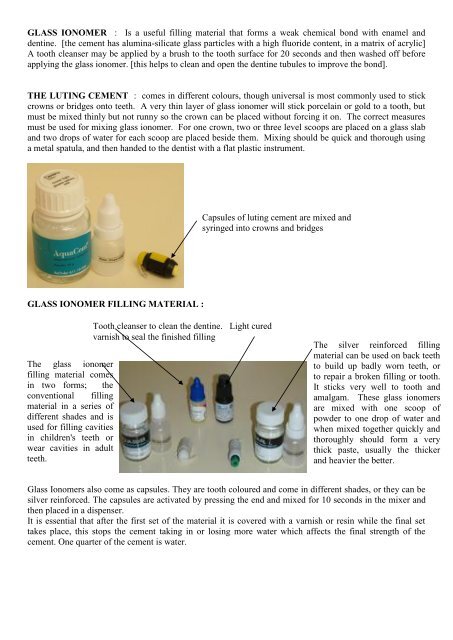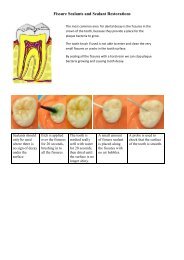You also want an ePaper? Increase the reach of your titles
YUMPU automatically turns print PDFs into web optimized ePapers that Google loves.
GLASS IONOMER : Is a useful filling material that forms a weak chemical bond with enamel and<br />
dentine. [the cement has alumina-silicate glass particles with a high fluoride content, in a matrix of acrylic]<br />
A tooth cleanser may be applied by a brush to the tooth surface for 20 seconds and then washed off before<br />
applying the glass ionomer. [this helps to clean and open the dentine tubules to improve the bond].<br />
THE LUTING CEMENT : comes in different colours, though universal is most commonly used to stick<br />
crowns or bridges onto teeth. A very thin layer of glass ionomer will stick porcelain or gold to a tooth, but<br />
must be mixed thinly but not runny so the crown can be placed without forcing it on. The correct measures<br />
must be used for mixing glass ionomer. For one crown, two or three level scoops are placed on a glass slab<br />
and two drops of water for each scoop are placed beside them. Mixing should be quick and thorough using<br />
a metal spatula, and then handed to the dentist with a flat plastic instrument.<br />
Capsules of luting cement are mixed and<br />
syringed into crowns and bridges<br />
GLASS IONOMER FILLING MATERIAL :<br />
The glass ionomer<br />
filling material comes<br />
in two forms; the<br />
conventional filling<br />
material in a series of<br />
different shades and is<br />
used for filling cavities<br />
in children's teeth or<br />
wear cavities in adult<br />
teeth.<br />
Tooth cleanser to clean the dentine. Light cured<br />
varnish to seal the finished filling<br />
The silver reinforced filling<br />
material can be used on back teeth<br />
to build up badly worn teeth, or<br />
to repair a broken filling or tooth.<br />
It sticks very well to tooth and<br />
amalgam. These glass ionomers<br />
are mixed with one scoop of<br />
powder to one drop of water and<br />
when mixed together quickly and<br />
thoroughly should form a very<br />
thick paste, usually the thicker<br />
and heavier the better.<br />
<strong>Glass</strong> <strong>Ionomer</strong>s also come as capsules. They are tooth coloured and come in different shades, or they can be<br />
silver reinforced. The capsules are activated by pressing the end and mixed for 10 seconds in the mixer and<br />
then placed in a dispenser.<br />
It is essential that after the first set of the material it is covered with a varnish or resin while the final set<br />
takes place, this stops the cement taking in or losing more water which affects the final strength of the<br />
cement. One quarter of the cement is water.
Resin-modified glass ionomer cements – These have a resin in them which will set when a curing<br />
light is applied. That is only an initial set and the cement must still have a varnish or resin to cover them<br />
while the setting process is complete.<br />
You can tell if the cement is “light cured” as the name usually has LC after the name.<br />
Remember the tooth cleaner is applied<br />
The tooth washed and dried<br />
Varnish resin or Vaseline applied<br />
when finished<br />
Eye protection is essential.<br />
The light curing lamp is very<br />
bright and will damage the<br />
eyes if a light shield is not used







